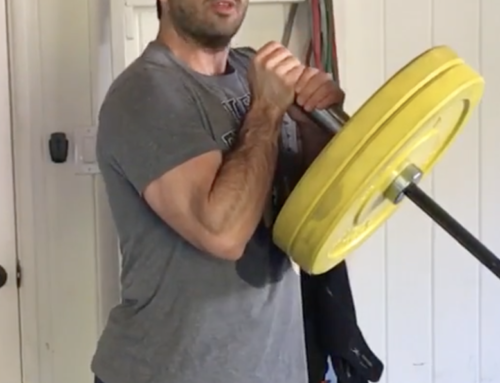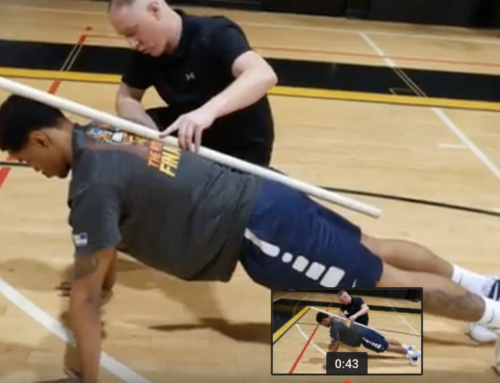3 Strength Moves Every Basketball Player Must Master
By Shelby Turcotte, Basketball Coaching Academy
If you’re currently using the leg press and doing lots of push-ups you need to listen up. If you think your plyo program that promises 20 inches in 2 days or less is going to take you to the promise land, you need to listen up. If you’re all about balancing on a Bosu ball while juggling Indian clubs because it’s ‘functional,’ you need to listen up.
Athletic strength isn’t about any of the above. As a matter of fact, it’s not about what is simply challenging or hard at all. It’s about what works. It’s about what makes you the strongest, most explosive player on the basketball court. Here are 3 exercises that do just that.
1) Split Squats – Forget the barbell squat, the split squat is the cool kid in town now. It not only lends itself to tremendous load (I’ve had high school athletes achieve more than 250lbs for reps), but also is a valuable tool in building stability similar to that which you would see on the court.
So what is the split squat and how do you get there? The split stance is one of the most fundamental athletic positions (this is the stationary version of the squat). This can be achieved by starting with the back knee below the hips on the ground, front knee over the middle of the front foot, and the chest up tall. The split squat is simply raising and lowering from this position.
It’s amazing to watch how challenging this position can be for most athletes. The staggered stance forces the hips and core to stabilize while simultaneously driving motion (mobility) into the front of the trail leg. I recommend beginning with simply body weight as part of a daily dynamic warm-up and then build from there.
All of my athletes go through a variety of progressions and variations of the split squat with the ultimate goal of achieving a bodyweight (or more) split squat for 5 reps. I do this by loading the athlete with a barbell in the front rack position. This movement not only has enough resistance and weight to challenge an athlete from a strength standpoint, but the weight will force the athlete to stabilize through the trunk to prevent any movement. If you think holding 250lbs on your shoulders is hard while front squatting, wait until you see what it feels like in a split squat. In addition, the unsung hero of the split squat is the back foot and lower leg. This position forces the muscles of the lower leg and foot to stabilize while creating movement – a movement that is simulated over and over again on a basketball court when pushing off and accelerating.
2) SA Bench Press – I like the bench press. As a matter of fact, despite what some coaches may be telling you about how it’s not ‘functional,’ and that it only works the upper body, done correctly, it is in fact a total body movement. I’m going to do you one better though; if you think the barbell bench press is great, you need to start using the single arm dumbbell bench press.
Formally thought of as the ugly sister, this movement has gained notoriety in recent years in large-part to it’s ability to ‘rip’ up the core. The important teaching point of the SA bench press is that you set your body properly before beginning the movement (just like bench pressing). Your feet should be set just outside of shoulder width with your feet pulled underneath your knees; make sure to tighten your quads (top of thighs) and drive the balls of the feet into the floor. This is your stable base. Make sure you contract your glutes (butt) to help control your body through the hips. You should have a normal curve or arch in your lower back and your shoulder blades squeezed down and back (just like in a row) and you should be driving the top of your shoulder blades into the top of the bench. This will help stabilize your shoulders which will allow you to create more force and push more weight. Lastly, you want to take a deep breath into your stomach and flex or ‘brace’ your abs like you’re going to get punched in the stomach.
The rest of the movement is executed just like a dumbbell bench press with two dumbbells except you’ll notice a large rotational force wanting to pull the body off the bench as you lower the weight. This where it’s important to keep your body tight and resist that motion that the weight wants to create through your trunk. My long-term goal is to have my athletes use at least 40% of bodyweight for about 8 reps.
It’s important to start light enough that you can maintain proper position of the entire body. Don’t be surprised if you’re initially using less than than 25% of your bodyweight. Make sure you’re not using your off-hand to stabilize at all. The habit is to want to grab the bench or flail it to out the side to help counter-balance the movement. DON’T DO IT! Fight the urge by putting the free hand on the hip throughout the entire movement.
3) Scissor Stance Landmine – One of my favorite exercises/pieces of equipment is the landmine (now known by some as the extreme core trainer). The days of traditional crunches and sit-ups are long gone. In order to effectively train your body to stabilize athletically, you must teach all of the muscles involved in the movement to fire together. So while you may have used the landmine in the past, I doubt you’ve used it like this before.
Similar to the split squat, the scissor stance is another staggered foot position stance. The biggest difference is that the feet will be position 1 behind the other with about a shoe length in between (I will sometimes switch the length depending on the movement). This inline position will really force you to have to stabilize with the entire body from the feet/legs/hips, all the way up through the shoulders and into the hands.
It is learning to contract and stabilize in this position that allows a player to take a bump or get knocked off balance and yet still finish making a play. It is a position like this that teaches an athlete to integrate all of the core training, leg strength and upper body balance to a movement that is much more similar to that which they will see on the court. Finally, the rotational component with the upper body, while similar to that of ‘ripping’ a basketball or being strong with the basketball, forces the body to adapt and be strong.
By integrating movements like these into your training you’re doing both yourself and your athletes a favor in teaching them movements that both build muscle and create strength, while positioning the body in a similar position to that which they must use on the court.
Coach Shelby is a peak performance coach. A self-proclaimed success junkie, he works with athletes and coaches both on and off of the court to improve their game. He is the owner of The Basketball Coaching Academy.







Leave A Comment